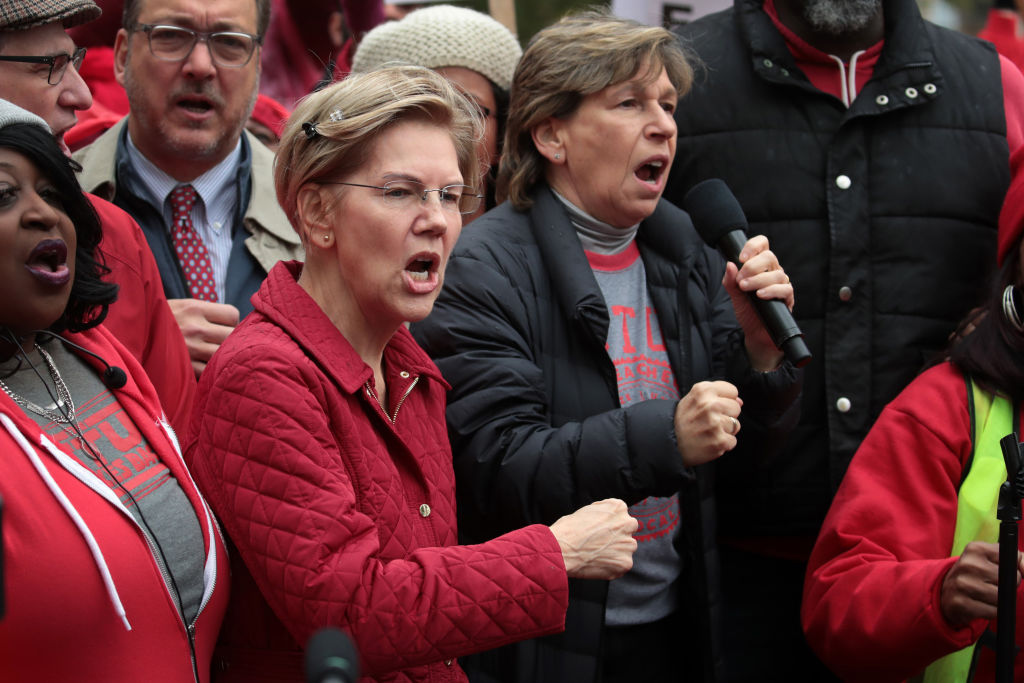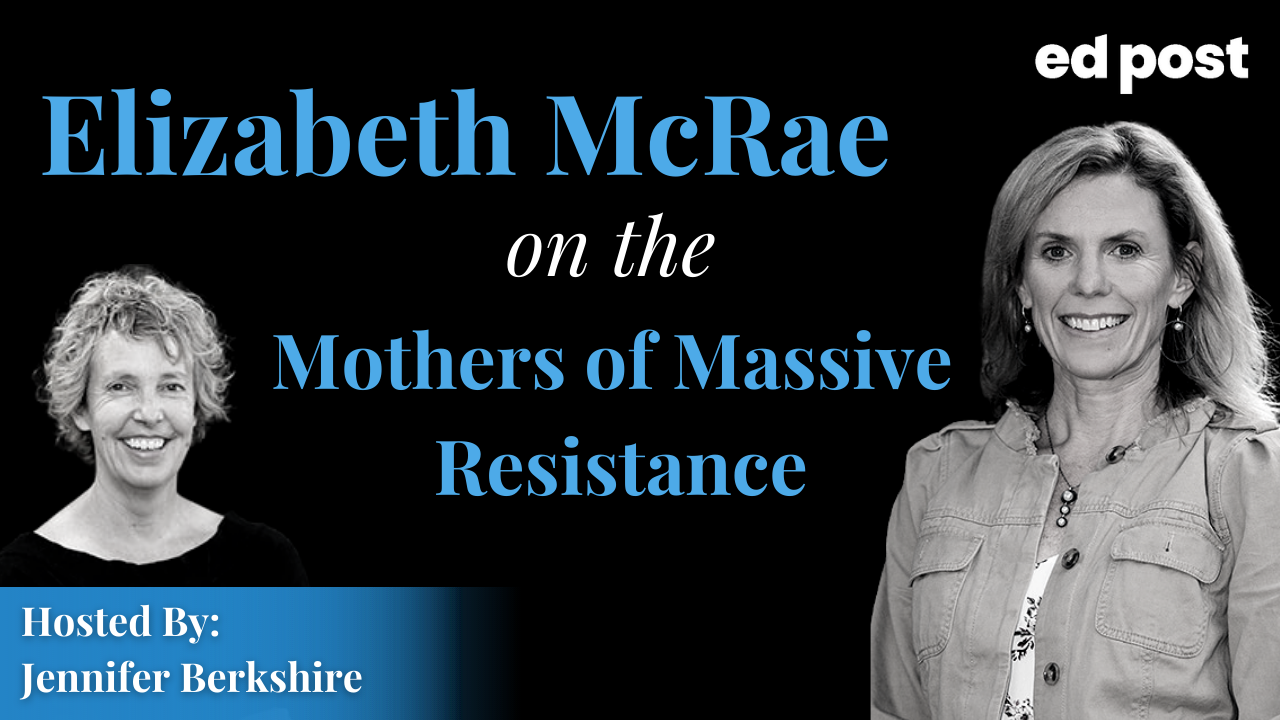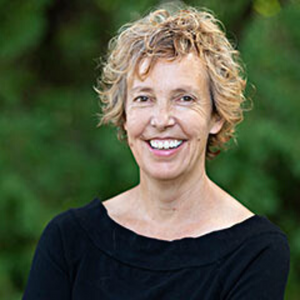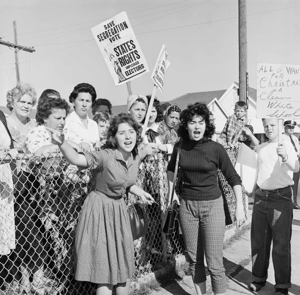Story

Interview

Author Elizabeth McRae on Mothers of Massive Resistance
"There are organizations that would—and political agendas that would—see themselves on the right side of history, or that are seen by the larger public on the right side of history, but are perpetuating institutionally the very hierarchies that they might seem to reject ... Nell Battle Lewis offers us a lesson to look behind the words and see what policies, institutions, and changes result from a language and a politics that may seem on its surface to be more progressive than it is."
Transcript of the Interview:
Jennifer:
I would imagine that knowing so much of the backstory, that it must drive you nuts when the story about the sort of current iteration of apparent outrage gets told as though it’s brand new — Moms for Liberty, the intense current focus on the schools that feels like it could be ripped out of the pages of your book or a new last chapter. So I wondered if you would just start. If you are in non-academic company, and you’re trying to explain to people around you … you know what, actually, we’ve seen this in the past, we’ve seen a lot of this in the past. What do you say?
Elizabeth:
Well, I think there’s a couple of kind of assumptions that come into play when we pretend that white mothers’ intervention in the school is new. And one is the assumption conservative women are outside of the mainstream of women’s politics, right, that it’s something new. And I think we see this, maybe not so much in the schools, but outside of it. So a surprise over Marjorie Taylor Greene or a surprise that white women voted for Roy Moore, or a surprise that white women voted for Herschel Walker. And the evidence is sort of overwhelming that we should not be surprised. Right? That using their position as sort of public mothers over public education, that white women have wielded enormous power.
White conservative women have wielded enormous power in the schools for decades, and have shaped curriculum, and have campaigned against multicultural education in the United Nations. And you know, when the report came out of the Trump White House about how history had to be taught, it could have been lifted from Pasadena in 1952. As mothers there in Pro America were arguing that a multicultural curriculum diminishes the importance of American exceptionalism and question the sort of halo around American founding fathers, and yeah, so in many ways, I think this is what’s percolating now, has been percolating for a long time, and also has really deep historical antecedents.
Jennifer:
Well, the title of the book is massive resistance. And to the extent that people in the listening audience are familiar with that, you’re gonna tell them right off the bat that they probably understand it wrong, that they think of it as geographically specific and historically limited. But what the book does is lay out that actually, it’s this sweeping historical story that really takes us all over the map, and quite a bit further toward the present than we would know. So sum up for us what people get wrong. What do we typically think of when we hear massive resistance?
Elizabeth:
In the way massive resistance had been used, it was the mass mobilization of white southerners after the “Brown” decision. And so it was after 1954, it was limited to the South, you know, the images we see in some of the famous photographs of white women protesting Ruby Bridges, going to school in New Orleans of white women yelling at the Little Rock Nine, those sorts of iconic images were located in the South and located in the time period from 1954 to 1964. If you've really stretch it, and you're right, I argue that we have misconstrued massive resistance. And that what changed was the allies of folks supporting segregated institutions and segregated public schools.
What we had had for a long time was white women working not just in the South, but in national networks, white conservative women working to maintain and reproduce racial segregation. And, for a long time, they had a lot of support. They had the support of the Supreme Court, they had the support of the Democratic Party, they had supportive the federal government writ large, of course, they had supportive state governments.
But beginning with World War II, some of those allies kept peeling off. And so their work didn’t fundamentally change, the change was from support to resistance because all of a sudden, they didn't have the sort of allies that they had had. But that work continues, they do not give up after they ostensibly lose with the Civil Rights Act and the Voting Rights Act. You know, I sort of skipped the late 1960s and went right to the anti-busing, but I think there could have been chapters there, and then you could continue it. Certainly, from anti-busing, you could draw some lines up to today, there's some, there's some historical things that change for sure.
Jennifer:
So this project is called Jane Crow, which I think is just such a great name. And she is your book. And I think what people would be really surprised by is how, how we can look all over the map and find her.
She’s not just in the South, as you were describing, and she's not just in Boston, which I think people will know, they will conjure up an immediate image. But she's also in Pasadena, much more explicitly organizing around anti-communism, or even to keep you know, mental health services out of the schools. So, it really was all over the map, but also the breadth of the causes that get—but you make this really forceful case at its root, you know, they’re like, well, they may be focused on different specific outrages—at the root is always upholding the architecture of segregation.
Elizabeth:
Yes, and I think the women that I write about in the book, and they’re mostly sort of middle-class, educated women, not exclusively, but mostly, they do have a list of causes. They’re really politically active. And they make connections, logical or illogical, between anti-communism, between the post-colonial independence movements, between the Peace Corps, between sex education and mental health, and upholding segregated schools or segregated institutions. Maintaining sort of a white supremacist political landscape.
For some of them, like in Pasadena, they might talk about it and do talk about it differently in their campaigns against the United Nations. Right. They don't use some of the overt segregationist and racist language that we see coming out of the Jim Crow South. But they are in communication with the women that are leading these causes in the Jim Crow South.
And there’s a debate, right, or recognition that in different places, you have to use different language. And so they embrace colorblindness because they know it can uphold racial segregation. They are anti-communist, but they also understand that that has sort of significant repercussions for segregated political and social, and cultural landscape.
Jennifer:
The vision for public education or really more accurately, their list of complaints about the schools will feel instantly familiar to people. So you know, railing against progressive education along the lines of John Dewey, anything having to do with multiculturalism, but also the complaints that the schools are sort of inadequately patriotic.
There's a book that was on the bestseller list for most of the summer, co-authored by a Fox News co-host, Pete Hegseth, “Battle for the American Mind,” that makes those exact arguments. And so that seems like an example of on the one hand, their complaints seem kind of disparate. But on the other hand, they’ve been sort of remarkably coherent over the decades.
Elizabeth:
In some ways, it’s like nailing jelly to a wall. They just trust so many arguments. But it's also really strategic, right, that for a lot of the decades of the middle part of the 20th century, white women realized that they could wield enormous authority in public education. It’s always a battleground, but it’s the place they could work without being an elected official. You know, they could campaign for school board officials, they could get appointed to textbook selection committees.
It was a way that they could function, and I think in doing that, they understood that teacher training, that the curriculum, that the textbooks and materials that students did, that their extracurriculars like essay contests, that all of that could be different fronts to maintain their version of a Jim Crow education, when they believe that’s the way the United States should be, right?
It should adhere to a racial hierarchy, and celebrate white historical actors, and actively erase – in a weird way, they were really conscious of Black history – because they made sure that they could erase it in the curriculum and textbooks.
Jennifer:
Another thing that really surprised me was just how far back the fears of a federal Department of Education went, actually the fears long precede the existence of a department. So, you know, I knew that there were complaints when, when it was started and that it was, you know, seen as sort of a stop to the unions. And there were always concerns about federal overreach. But you chronicle that there are complaints decades before that, and I just want you to walk us through what were people so concerned about.
Elizabeth:
Well, I think they’re concerned. And they make the argument that if the Department of Education begins to sort of make inroads into public education, then the inequity of the institutions in segregated institutions, and at that point, I was writing mostly about the South, would be up for grabs, right would be up for sort of constitutional review. And so the idea that once the federal government had some sort of influence and oversight of the public schools, that they would begin to lose that control was not invalid. And this is not flushed out as much in the book. But at the same time that these conservative white women are working to shape the curriculum in a way that upholds and reproduces racial segregation. Black women are also pushing for a recognition of African American history. You have the birth of what was then Negro History Week. And Carter Woodson, you have Eleanor Roosevelt, embracing black history and making speeches about in Chicago and writing about it in my day, which was her column. And so what these white segregationist women see is that national attention and federal intervention will be something that encroaches on their ability to really manipulate it, in many cases, right American history to serve the purposes of a segregated president.
Jennifer:
The other thing that just felt so relevant to the president was this perpetual lament among the mothers that their influence over their own kids is waning, and they see evidence of it everywhere. So I, so I just wondered if you would just talk a little bit about that.
Elizabeth:
I mean, I would like to do more actual research on this, but I do see early on that in the 20s, and then the 30s, and really escalating after World War II, this concern that their children are learning things that are different than they would like them to be taught, right and I think they're not as explicit about it, and the larger landscape, right, but there's a lot of other cultural influences that are changing, also shaping young people’s minds at the war, you have people going away, you have the television, you know, so there’s other things, but schools seem to be a place that they think they have controlled and can control. And so you see this, I think you’re right lament about an erosion of parental authority.
And this notion that as a mother, as a white mother, I should get to control what my child learns at school. And I mean, that is just all over the news today, right as people take over as the right pushes to take over school boards, and people call and complain about learning about the civil rights movement because that's critical race theory. I mean, I think, yes, it’s hard not to draw really clear lines in between
Jennifer:
So I want to ask you another question about the present because this is just something that I haven't figured out. I found your argument about a segregationist agenda and a white supremacist vision so convincing, but then I see sort of how quickly these groups have pivoted from critical race theory, which, you know, really took off in the summer of 2021, and now has kind of petered out another onto a, quote-unquote, gender ideology. And I just wondered, you know, I’m not sure how to think about that, if that’s if this is a new direction, or if it’s just another more flexible way of upholding the authority of white women.
Elizabeth:
It’s strange, in a sense, because I think, in many ways, public schools are ahead of sort of understanding and addressing kind of a fluid gender identity, that the sort of public is just catching up to, right? I mean, like, it’s not a new issue for public educators, I mean, you know, it didn't just pop up in the last two years, they have been addressing, in many places, students who have a more fluid gender identity, and having to address those things. And so one difference between sort of the current political landscape around public education in the time I wrote about it is [that] evangelicals weren’t major players in the era that I wrote about, right? And that’s one of the reasons the book is what it does so that I don’t have to. One, it was time to end it. But two, I think that the sort of rite really changes with the influx of evangelical fundamentalism and the rise of the sort of political entry of evangelicals into the political landscape. And so that has also shaped the sort of gender ideology campaigns—anti-CRT campaigns, too—but I wonder if that's not also a significant factor in this sort of campaign at this moment.
Jennifer:
That's a really good point, it is possible to read your book and come away feeling somewhat down. Because you lay out so convincingly that this really the story of our, you know, of the 20th century is this massive disparate resistance. And you know, it really is the sort of water we swim in. I wonder how like, where did you find hope in the stories that you were telling? And, you know, I'm obviously hoping that you will, you'll talk a little bit about the allies?
Elizabeth:
Well, for much of the era that I’ve heard about, or certainly after World War II, the way segregationist women thought they were losing. I mean, they believed, right, that they were in this sort of deathmatch, right, with a more progressive, democratic, liberal moment, or era and that, and they did, in many ways, they could catalog their losses, right, as a sort of list ... But I think where I find hope is that they have to work really hard in all these places in society to uphold this regime, if you will, or uphold these various versions in shape of white supremacist politics.
And if something takes that much work, right, culturally, politically, in sort of public welfare and public education, if it takes that much work, then there are lots of places that those of us that do you not want a society built on racist and gender hierarchies, right. It gives us lots of places to work. So I guess that’s my hope is that you don't have to run for national office to begin the work of dismantling systems. I think you have to recognize where they’re upheld, whatever your gifts are, that they can be employed in this way, I think to dismantle because they were working all these places.
When the book came out, I gave a talk to the local NAACP and, and I know there’s debates about, like, do you adopt the strategies, the political strategies of the enemy, if you will, and but we were talking, and they start in an essay contest right about sort of democracy and voting rights and racial equality in our area schools in an effort just to begin to kind of overcome a long legacy of those being the purview of more conservative organizations. I don't know that it has shifted. I mean, we all went red on Tuesday. But anyway, you know, it's a long game. I think.
Jennifer:
Not everyone who appears in the pages of the book is a force for regress, right? There are also all sorts of inspiring stories of allies. And I wondered if you could just tell us a little bit about the more hopeful part of that story.
Elizabeth:
The anti-busing story in Boston is dramatic, right, and sees the national headlines. But at the same time, there was a whole group of people across racial and class boundaries that gathered and were like a rumor control center, right? So when Louise de Hicks or Roar, you know, release some kind of lurid tale, they would go investigate it in the schools and release what had happened actually, right, rather than what Roar had said was happening, right, which is often around issues of sex, right, like teenagers having sex across the color line, consensual or not. And so I think what you had right was a whole group of people who came together in this kind of rumor control center, right, to counter the efforts abroad. And I think you see allies, not as many as I would like.
Jennifer:
I understand you work with pre-service teachers. I’m just so curious about how you bring all this historical knowledge to your work. How do you give them the gift of understanding without burying them beneath history that's not always the most inspiring?
Elizabeth:
Probably the answer is not very well, but I think for most of my pre-service teachers, not all, but most of them, enter with a belief that public education, done well, can create a more equitable society. So [you] already have kind of a captive audience, which is different, not all of them think that, but most of them come to public education, right, with kind of rose-colored glasses of its potential.
And it's hard, right, because the story I tell is also about how public education can reify hierarchies, right, and be employed for a very different political outcome, an undemocratic —little d— political outcome. I think the pre-service teachers have seen lots of challenges lately. So I had a master's student who was teaching the civil rights movement last year, and she got letters from parents that said, they didn’t have to teach their children, didn’t have to do their homework, because she was teaching critical race theory. Right. And her response was, I’m teaching social movements in the civil rights movement…But I think my job now is to also equip them to think about how to counter sort of this insertion of parental authority into the very material that the state has asked them to teach.
Jennifer:
It really is amazing how it just feels so ripped, right from your book, right? I can imagine you writing about a campaign to have women write letters, you know, opting their kids out of homework about a particular lesson.
Elizabeth:
I mean, it is the same, and I think, frankly, the strategies of grassroots organizing— many of them are the same across the political continuum. I mean, a letter-writing campaign could also work on the other side, I think.
Jennifer:
So your book is filled with conservatives, but they're not the only characters in the story. There are some quote-unquote, progressive actors, folks that see themselves, you know, warring on behalf of good, and I'm thinking of one in particular, and her name was Nell Battle Lewis.
Elizabeth:
I think Nell Battle Lewis is fascinating, right? So if we took her bullet points of her biography, we would imagine that her politics end up very different right. She's well educated, travels abroad, goes to school at Smith, and she campaigns really hard against the KKK in the 1920s and 1930s in North Carolina, and it was a significant political player. I think she’s interesting because I think I call her a liberal white supremacist in the book.
And I think so often her language was far more muted, right than the Klan, for example. She is opposed to racist violence. She’s for prison reform. But it’s really so if you looked at her language, and a lot of people did and see her as a sort of leading light of the South, but much of that was in pursuit, I think, right, was in pursuit of making a white supremacist regime that worked, but wasn’t violent, right.
That wasn’t sort of the…that didn't bring national attention to kind of a violent, overtly racist kind of regime—that she believed that white supremacy and segregation could be upheld if there were more equitable institutions, but she never believed in racial equality.
And I think that the lesson of Nell Battle Lewis is one that we should think about today because there are organizations that would and political agendas that would see themselves on the right side of history or that are seen by the larger public on the right side of history, but are perpetuating institutionally the very hierarchies that they might seem to reject. You know, Nell Battle Lewis offers us a lesson to sort of look behind the words and see what policies and institutions result and changes result from a language and a politics that may seem on its surface to be more progressive than it is.
This transcript was created using speech recognition software. While it has been reviewed by human transcribers, it may contain errors.



